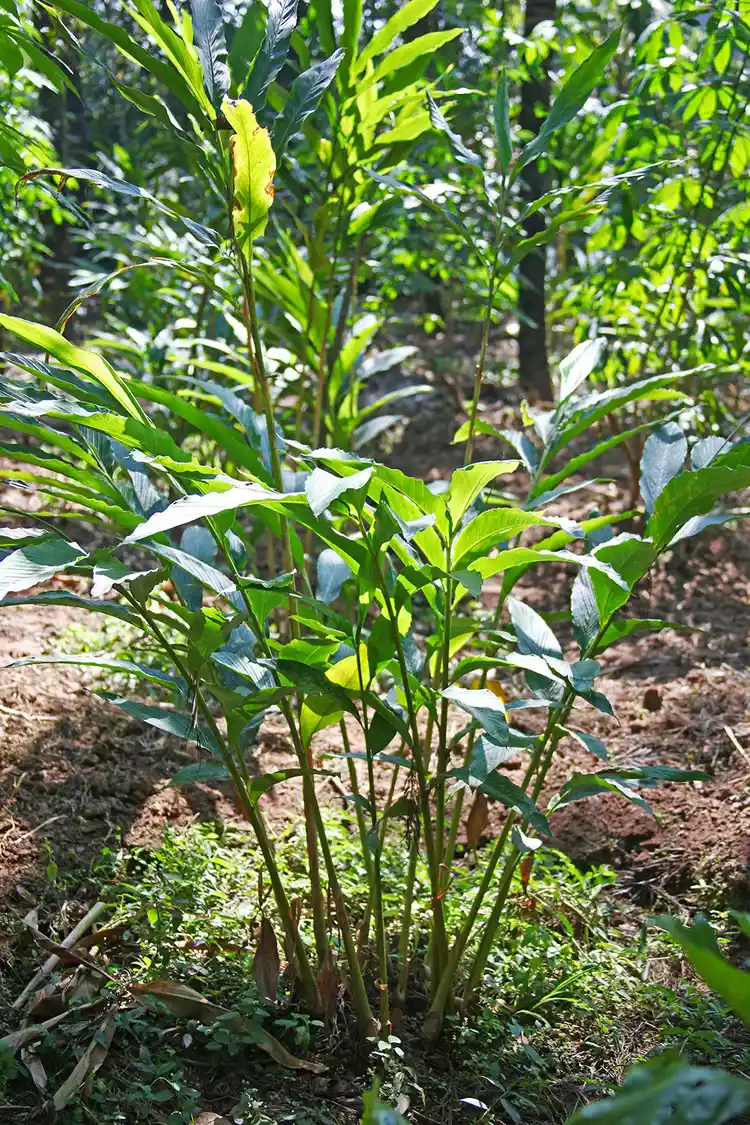How to Plant and Grow a Cardamom Plant

The beautiful perennial herb cardamom flowers in early spring through summer and produces edible pods and seeds to flavor desserts, meats, and teas. Even when the popular tropical cardamom plant isn't flowering, its mounds of lush leaves add interest to a tropical container garden or greenhouse. Its straw-like leaf sheaths start small, grow larger, then open like flowers.
This rainforest native requires constant warmth and high humidity, so it can be tricky to grow this spice outdoors in many regions of the United States. Cardamom should be brought indoors to overwinter, and it can work as a houseplant. However, it rarely flowers when grown in a container, so it won't produce flavorful seeds indoors for your culinary creations. You'll also need to give this plant plenty of space—it can grow from 6 feet to 16 feet tall. Cardamom grows like ginger, with flowers and pods produced low on the plant with the help of insect or hand-pollination.
Cardamom Overview
| Genus Name | Elettaria cardamomum |
| Common Name | Cardamom |
| Plant Type | Herb, Perennial |
| Light | Part Sun |
| Height | 6 to 15 Feet |
| Width | 4 to 10 Feet |
| Flower Color | White |
| Foliage Color | Blue/Green |
| Season Features | Winter Interest |
| Zones | 10, 11 |
| Propagation | Division |
Where to Plant Cardamom
Plant cardamom under the shade of tall trees in hot, humid, consistently moist, tropical rainforest conditions where daily temperatures infrequently dip below 72°F. Cardamom will only survive outdoors in the warmest parts of North America. If outdoor temperatures drop below 50°F, the plant will suffer significantly.
Cardamom plants can be wintered indoors in containers in a warm, humid environment, such as a steamy bathroom. The plants, however, will not flower or produce fruit when grown indoors in pots. The plant grows tall by layered leaf sheaths and flowers in two or three years. It will reach its full production after four years and continue producing for 10-15 years.
Guatemala is the largest producer of cardamom, with global export production. Large quantities are also grown in India. The plant is native to Ceylon and India and is frequently used in Indian and Asian cuisines. Its height can range from 6-16 feet before it puts out pods.
Cardamom Care Tips
This rainforest native requires constant warmth and high humidity, so it can be tricky to grow this spice outdoors in most regions of the United States.
Light
Plant cardamom plants in a partly shady spot outdoors or indoors near a sunny window without supplemental electric lights. Direct sun must be avoided.
Soil and Water
Cardamom prefers humus-rich soil that is slightly on the acidic side. The soil must remain moist for cardamom plants to thrive, so water the plant regularly. Misting cardamom plants frequently will help simulate their native rainforest-type growing conditions.
Temperature and Humidity
When growing cardamom outdoors or indoors, you’ll need to ensure temperatures are above 50°F. When grown indoors as a foliage plant, place the pot on a large saucer of constantly moist pebbles to increase humidity around the plant.
Harvesting Cardamom
Flowering begins in early spring and lasts through summer. After 120-plus days, the pods mature. Harvest the pods before they split open and when the seeds inside the pod are dark brown to black. You’ll know when the pods are ready to be picked because they will twist off easily in your hand (the immature pods will hang on tight). After removing the pods, rinse them quickly in cold water. Dry them on a baking sheet in your oven or in your dehydrator at 90°F–125°F.
Potting and Repotting Cardamom
To grow cardamom plants in pots, select a wide and deep container to retain moisture and accommodate the plant’s large size. Make sure the plant also has plenty of space to grow vertically after its third year. To keep the soil level, use compost tea weekly and top off containers with compost, leaf mulch, or light wood mulch.
Pests and Problems
Thrips are cardamom’s primary pest. You can recognize thrip damage on cardamom by the corky layer of injured tissue that looks like scales on the plant’s capsules. The insect causes shriveled capsules with gaping slits while it sucks on the capsule’ sap—the condition is known as “cardamom itch.” Although the insect’s damage looks ugly, using insecticides is not justified since the thrips that caused the damage are usually gone by the time the plant damage is noticed. The most effective way to prevent thrip infestation is to use row covers.
How to Propagate Cardamom
Dividing Old Cardamom Plants
You can propagate new cardamom plants by dividing old plants. Do this by loosening the soil around the parent plant and lifting its roots from the ground. Then separate a plant segment with 4 to 5 leaf sheaths, and plant it in a new area. Replant the rest of the old plant in the same spot.
Growing Cardamom from Seed
You can grow cardamom from seed. Sow seeds ¼ inch deep in 70°F-80°F. Keep soil moist until seeds germinate in about 20-45 days. Be sure to plant extras because germination rates tend to be low.